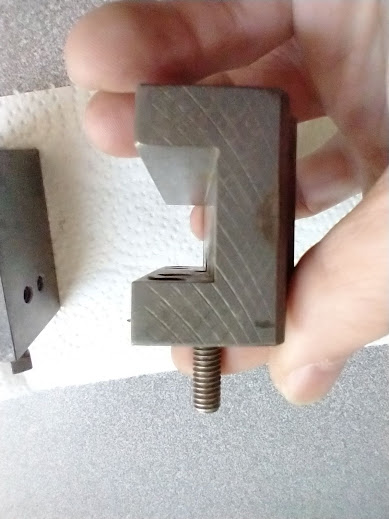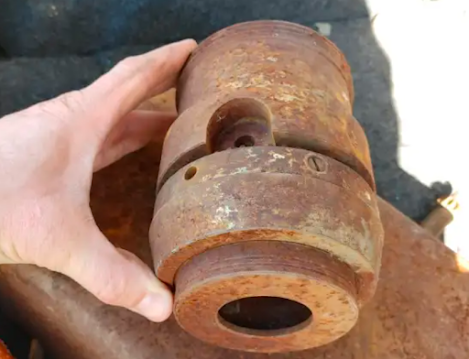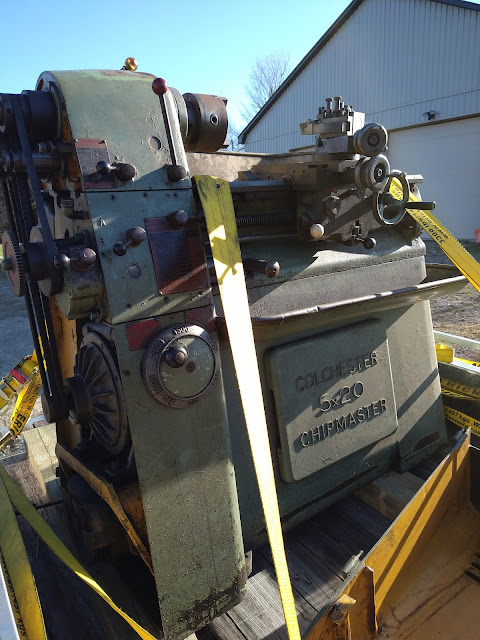Since the Chipmaster was designed to use a coolant system and has a great splash guard, a deep rear coolant well and already has most of the parts from the coolant system with it I plan on using coolant when turning precision parts.
The current state of the lathe is pretty sad, there are plenty of chips out of the finish, gross flaking from filler detaching from the base metal, and spots where the paint, primer and filler have been entirely worn through. If it is to reside in a garage and last another 55 years it will need a new finish.
So in my minds eye I see this machine as a showpiece that I have stripped down to bare metal and carefully refinish with fillers and sanded smooth before applying a multiple coat automotive finish.
I'm aiming for a quality finish without going totally professional on the application and high end materials side of things.
My thought is to go with two coats of rattle can applied zinc chromate primer on the base metal to provide corrosion protection, a good base for applying fillers, and a matt surface that will allow me to judge where I need to apply thick filler to porosities in the casting and to assess where there will be a benefit of using a thin filler material prior to the next steps.
After the primer and filler application I'll use both a three step finish of:
Four coats of two pack cold cure epoxy high build MIO paint to achieve a dry film thickness of about 700 microns,
Two or more coats pearl automotive base coat paint,
Application of new labels, gearing charts etc, decals,
Two or more coats of urethane enamel clear coat.
I'm considering a colour scheme of orange main colour, purple contrast colour and matte black on the inside of the chip tray, motor housing, storage compartment and coolant sump.
I'm not yet decided on what this colour scheme will mean for the original signage plates, replacement rather than reuse is most likely. I may experiment with selective multi-colour anodising to create these plaques, or decals applied to aluminum plates.
For those not familiar, selective anodizing is a multiple step process that makes it possible to combine the properties of two or more separate treatments on the same part, in this case two or more colours by masking off areas so that only selected areas get the desired treatment in each step.
I have access to anodizing company via a business that regularly has parts anodized. I was thinking that I can get the parts Type 2 anodized and take delivery of them within hours of the end of that process and then dye the plates myself with organic dyes in three steps.
The tricky part of attaining quality anodized layer of suitable thickness is left to the professionals, and I shall perform the hard selective dying process the professionals may not wish to perform.
I'd use a minimum of three dye colours, and use multiple masking layers of laser cut green polyester plating film. Orange base layer overlaid with purple and black layers to bring out orange text with two different colour surrounds. Dying of aluminum anodization does not always follow typical colour rules... but normally of you overlay purple on orange you will get brown. If this is the case I'd just have a more complicated masking task that required careful registration of the layer masks.
The goal, to recreate something like this:
But on aluminum where all text is orange, the red changed to deep purple, and the black being black of course. I hope that I don't fail but if I fail my fall back would be multiple coats of paint spray applied with similar masking techniques.
I anticipate that the greatest issue will be masking related, particularly getting smooth edges on the tiny cut out letters, and removing the cut out pieces from the masked part. I've seen similar issues when using same technique in spray painting. I will mask, then low power laser cut the masking film, then pick out the areas for the color I wish to dye. Rinse and repeat for each of the three colours I anticipate using.
I'll likely just seal with the same urethane clear coat I'll use as the final finish coat on my lathe.
If the masking is an issue I shall consider this other options
Option 1:
Dye the parts solid colours in their respective areas, and then use laser printer to mark the graphics. This of course means I'll only get white text on black and purple, unless the laser I use is strong enough to create a deep etch into which I can rub orange urethane paint.
Option 2: Have the plates lightly blasted to create dull matte finish. Plain anodize and dye orange. Then create waterslide decal of the graphic in black and red, and affix decal to the plate using water based urethane as follows:
Coat the plate with thin even coating of matte urethane... allow to tack up. Apply the wet decal by sliding it into position and then wipe off excess water with a damp sponge brush and tamp the decal into place. Then cover the decal with a clear plastic film and run the plate thru a cold laminating press. This should bond the decal sufficiently well so that it does not delaminate in the future.
Then I could cover with one or more coats of matte urethane to seal and protect the decal and to seal the edge of the decal (which must be smaller than the plate) so the edges don't lift.
If I knew how it was done and had appropriate laser printer I try the Trumpf method of varying the depth of laser etch to expose the desired dye level from a multilayered anodised finish.









































.jpg)







.jpg)
.jpg)
.jpg)
.jpg)
.jpg)
.jpg)
.jpg)
.jpg)
.jpg)
.jpg)
.jpg)
.jpg)

